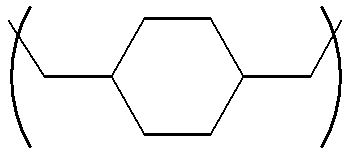Preparation of partially cross-linked polymers and their use in pattern formation
a technology of cross-linked polymers and polymers, which is applied in the field of preparation of partially cross-linked polymers and their use in pattern formation, can solve the problems of inefficiency and reproducibility of cross-linking between the two poly(hydroxystyrene) polymer chains, the amount of cross-linking is sensitive to baking conditions, and the amount of cross-linking is not reproducible, so as to reduce the amount of volatile alcohol by-products, less resist shrinkage, and less chance of coating the lens
- Summary
- Abstract
- Description
- Claims
- Application Information
AI Technical Summary
Benefits of technology
Problems solved by technology
Method used
Image
Examples
examples 1 and 2
below illustrate the synthesis procedure involved in generating the acetal polymers.
example 1
Synthesis of partially cross-linked Poly[p-(2-ethyl hexyloxy ethoxy) styrene / p-hydroxystyrene]
A polymer solution was prepared by dissolving 90 grams of poly (p-hydroxystyrene) (PHS) in 310 grams of propylene glycol monomethyl ether acetate (PGMEA) at room temperature. The weight average molecular weight of the PHS was 8000 and the polydispersity (PD) was 1.17. The solution was concentrated by distilling at 60 to 70.degree. to form a 30% solid solution. To this concentrated solution, 1.47 grams of cyclcohexanedimethanol divinyl ether, 29.12 grams of 2-ethyl hexyl vinyl ether (EHVE) and 120 milligrams of oxalic acid was added and stirred at room temperature for about 16 to 24 hours. After the reaction, 4 grams of pyridine was added and stirred for 2 hours. The solution was then washed with a solution of hexane / acetone / water. The PGMEA layer was separated and distilled to remove the residual hexane / acetone / water. The polymer was found to have 20-22% blocking levels of EHVE groups by .s...
example 2
Synthesis of partially cross-linked Poly[p(cyclohexyloxy ethoxy) styrene / p-hydroxystyrene]
A polymer solution was prepared by dissolving 60 grams of poly (p-hydroxystyrene) (PHS) in 310 grams of propylene glycol monomethyl ether acetate (PGMEA) at room temperature. The weight average molecular weight of the PHS was 8000 and the (PD) was 1.17. The solution was concentrated by distilling at 60 to 70.degree. to form a 30% solid solution. To this concentrated solution, 1.47 grams of cyclcohexanedimethanol divinyl ether, 15.75 grams of cycolhexyl vinyl ether (CHVE) and 90 milligrams of oxalic acid was added and stirred at room temperature for about 16 to 24 hours. After the reaction, 4 grams of pyridine was added and stirred for 2 hours. The solution was then washed with a solution of hexane / acetone / water. The PGMEA layer was separated and distilled to remove the residual hexane / acetone / water. The polymer was found to have 20-22% blocking levels of CHVE groups by .sup.13 C-NMR. The molecu...
PUM
| Property | Measurement | Unit |
|---|---|---|
| temperature | aaaaa | aaaaa |
| boiling point | aaaaa | aaaaa |
| reaction time | aaaaa | aaaaa |
Abstract
Description
Claims
Application Information
 Login to View More
Login to View More - R&D
- Intellectual Property
- Life Sciences
- Materials
- Tech Scout
- Unparalleled Data Quality
- Higher Quality Content
- 60% Fewer Hallucinations
Browse by: Latest US Patents, China's latest patents, Technical Efficacy Thesaurus, Application Domain, Technology Topic, Popular Technical Reports.
© 2025 PatSnap. All rights reserved.Legal|Privacy policy|Modern Slavery Act Transparency Statement|Sitemap|About US| Contact US: help@patsnap.com



